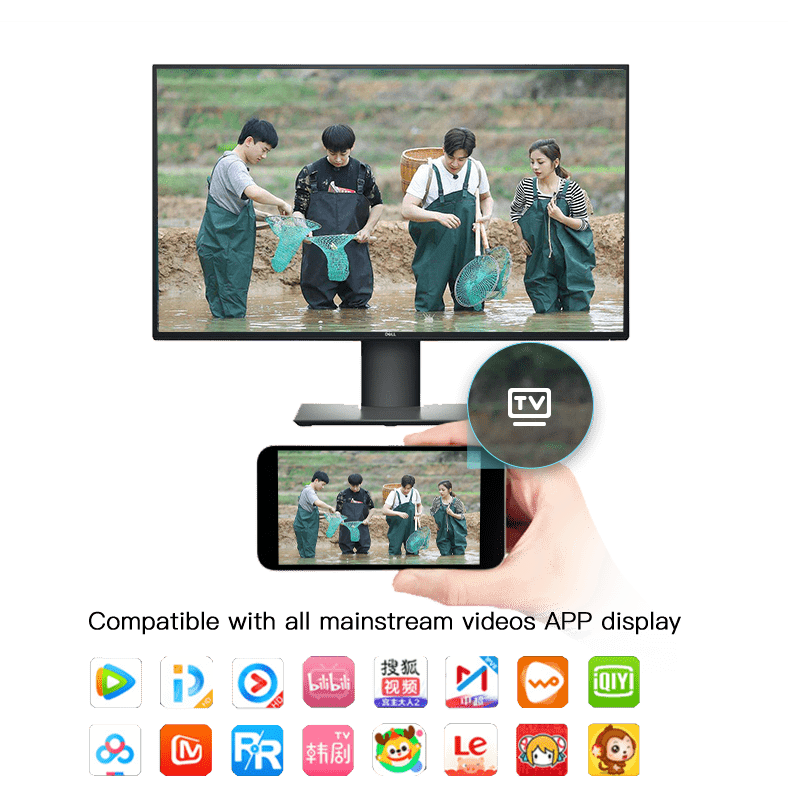Wireless screen mirroring refers to a way in which an intelligent mobile device client displays the screen image and sound of the device on another display device through WIFI, thereby achieving the same screen display. With the rapid development of business screen casting technology, there are more and more electronic products that support screen casting. So, what are the implementation technologies for wireless screen casting?

1. AirPlay screen mirroring
Airplay is a wireless technology unique to Apple devices. We can wirelessly transmit images, text, videos, and other information from iOS devices such as iPhones and iPads to AirPlay enabled devices through WiFi connections. Due to Apple devices not allowing third-party programs to obtain their screen images, many wireless projection boxes in China are implemented by cracking the AirPlay protocol.
The operation of screen mirroring is very simple. If you are an Apple phone, slide your finger up at the bottom of the phone screen, call out the detailed panel in the control center, click “Screen Mirroring”, select the device, and then proceed with screen mirroring. The Apple iPad also uses screen mirroring for screen mirroring, but the control center is located at the bottom of the screen and at the top right corner.
It is worth reminding that using AirPlay screen mirroring for screen mirroring requires ensuring that Apple devices and projectors are in the same local area network (same network segment) and cannot be used across network segments or VLANs. It can be difficult for enterprises with responsible network architecture to use.
2. Miracast Multi screen Interaction
Miracast is the certified name of the Wi Fi Alliance for devices that support Wi Fi Display functionality. Miracast projection technology is mainly used on two types of devices:
(1) Android phones that partially support multi screen interaction
Android phones above 5.0 typically come with the Miracast projection protocol, which allows for wireless display through internal settings without the need for any software installation or network support.

(2) Windows 8/10 computer
The WiDi protocol native to Windows 8/10 computers is an improved version of the Miracast protocol, allowing for direct screen mirroring without the need for any software installation.
But Miracast has two drawbacks that limit its use in high demand situations. One is that the underlying layer is the UDP transmission protocol, which is unreliable and easily interfered with during the transmission process, leading to screen distortion at the receiving end; The second issue is that each Android device manufacturer has designed different ways to open Miracast, resulting in the inability to provide unified training and promote it on a large scale.
3. DLNA push
The full name of DLNA is DIGITAL LIVING WORK ALLIANCE, which aims to solve the interconnection between mobile devices and consumer electronics. DLNA screen mirroring is usually used in combination with Miracast. Due to Miracast being a mirror projection, there is damage to the image. DLNA screen mirroring adopts the so-called push mode, which essentially pushes the content on the phone to the large screen (TV or projector) for playback in the form of URLs. This method ensures lossless image quality and has certain network requirements, but there is no image at the transmitting end, which is mostly used in home theaters and is not suitable for enterprises.

4. Private screen projection protocol
Generally, screen projection equipment manufacturers have their own customized private screen projection protocols, such as the BJcast protocol, which is a private screen projection protocol developed by Bijie Internet.
Suzhou Bijie Network Co., Ltd. (hereinafter referred to as Bijie) is a leading provider of enterprise intelligent office and smart education products and solutions. It is committed to using wireless screen projection, multi screen interaction, and rich intelligent office and smart education products to help enterprises and educational clients improve their learning efficiency, solve communication and management problems, and make everything simpler.
5. HDMI transmitter wireless screen projection method
HDMI transmitter wireless screen projection method, which means that the HDMI transmitter directly obtains screen projection information from the HDMI output interface of the transmitter, compresses and encodes it, and sends it to the receiver. There are two main protocols that use this screen projection method: first, devices that use the WHDI protocol; The second is devices that use the WirelessHD protocol. Its drawbacks are also very obvious. Many transmitting devices do not have HDMI output ports, so this method of screen projection cannot be used.
After reading this article, you should be able to understand the wireless screen mirroring technology for achieving same screen interaction, including Miracast, Airplay, DLNA, enterprise private screen mirroring protocol, and HDMI direct insertion screen mirroring technology. So, which method are you currently using?